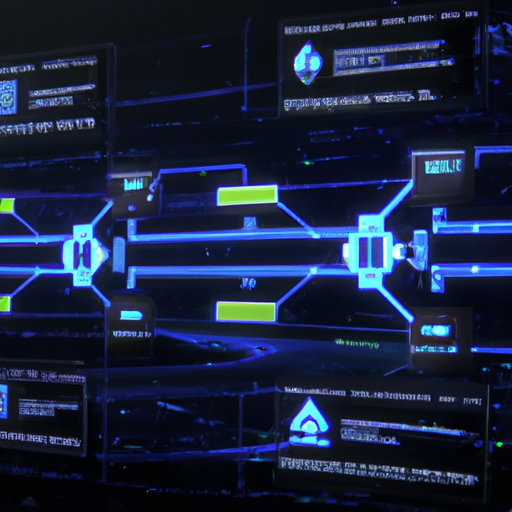-
Table of Contents
“ChatGPT Meets Web3: Revolutionizing Interactions in the Blockchain Universe!”
Introduction
ChatGPT Meets Web3: Bridging Conversational AI with Blockchain is an innovative integration of two cutting-edge technologies. It explores the potential of combining OpenAI’s language model, ChatGPT, with the decentralized and secure nature of blockchain technology, often referred to as Web3. This fusion aims to enhance the capabilities of conversational AI, making it more secure, transparent, and reliable. It opens up new possibilities for AI applications in various sectors, including finance, healthcare, and education, by leveraging the benefits of blockchain such as immutability, transparency, and decentralization.
Introduction to ChatGPT and Web3
ChatGPT, a state-of-the-art conversational AI developed by OpenAI, has been making waves in the tech industry with its ability to generate human-like text based on the input it receives. It’s a powerful tool that can be used for a variety of applications, from drafting emails to writing code, and even tutoring in a range of subjects. On the other hand, Web3, also known as the decentralized web, is a vision for a new iteration of the internet that is built on the principles of decentralization, transparency, and user control, primarily enabled by blockchain technology. The convergence of these two groundbreaking technologies, ChatGPT and Web3, promises to unlock new possibilities and reshape the digital landscape.
ChatGPT leverages machine learning algorithms to understand and respond to human language in a way that is remarkably similar to how a human would. It’s trained on a diverse range of internet text, but it doesn’t know specifics about which documents were in its training set or have access to any personal data unless explicitly provided during the conversation. This ensures that the AI maintains a high level of privacy and security for its users.
Meanwhile, Web3 represents a paradigm shift in how we interact with the internet. Unlike the current version of the web (Web2), where a handful of corporations control the majority of data and online services, Web3 aims to give control back to the users. It leverages blockchain technology to create a decentralized network where data is stored across multiple nodes, making it resistant to censorship and ensuring that users have full control over their own data.
The intersection of ChatGPT and Web3 opens up a world of possibilities. For instance, ChatGPT could be used to create decentralized AI assistants that live on the blockchain. These assistants could provide services ranging from personal assistance to professional consulting, all while ensuring that the user’s data remains private and secure. Furthermore, these AI assistants could be owned and controlled by the users themselves, rather than by a central authority.
Moreover, the integration of ChatGPT with Web3 could also enable the creation of decentralized social networks where users can interact with AI-powered bots. These bots could provide a range of services, from moderating content to providing personalized recommendations, all while operating in a transparent and user-controlled environment.
In addition, the combination of ChatGPT and Web3 could also lead to the development of new forms of decentralized education platforms. For example, AI tutors could provide personalized education to students around the world, breaking down barriers to access and democratizing education.
In conclusion, the convergence of ChatGPT and Web3 represents a significant step forward in the evolution of the digital world. By combining the power of conversational AI with the principles of decentralization, transparency, and user control, we can create a new generation of digital services that are more equitable, secure, and user-friendly. As we continue to explore the potential of these technologies, we can look forward to a future where AI and blockchain work together to enhance our digital lives.
Decentralizing Conversational AI
The advent of artificial intelligence (AI) has revolutionized various sectors, including communication, where conversational AI has become a game-changer. However, the integration of AI with Web3, the third generation of internet services for decentralized networks, is set to redefine the landscape of conversational AI. This fusion is embodied in the collaboration between ChatGPT, a state-of-the-art conversational AI developed by OpenAI, and Web3, a blockchain-based platform.
ChatGPT, a language model trained on a diverse range of internet text, has been instrumental in transforming the way we interact with machines. It can generate human-like text based on the input it receives, making it an ideal tool for tasks such as drafting emails, writing code, creating written content, and even tutoring. However, the integration of ChatGPT with Web3 is set to take this a step further by decentralizing conversational AI.
Decentralization is a core principle of Web3, which aims to create a user-centric internet where users have control over their data. In the context of conversational AI, decentralization means that the AI model is not owned or controlled by a single entity. Instead, it is governed by a network of users who collectively make decisions about its development and use. This approach can help to mitigate some of the challenges associated with centralized AI models, such as data privacy concerns and the risk of bias in AI decision-making.
By integrating ChatGPT with Web3, it is possible to create a decentralized conversational AI that is transparent, secure, and accountable. The blockchain technology underlying Web3 provides a public ledger that records all transactions and interactions with the AI. This transparency can help to build trust in the AI, as users can verify that the AI is operating as intended and that their data is being handled responsibly.
Moreover, the security features of blockchain can protect the AI and its data from malicious attacks. By distributing the data across a network of computers, blockchain makes it difficult for any single party to tamper with the AI or its data. This can provide reassurance to users that their interactions with the AI are secure.
Accountability is another key benefit of decentralizing conversational AI. In a decentralized model, decisions about the AI are made collectively by the network of users. This can help to ensure that the AI is developed and used in a way that reflects the needs and values of its users, rather than the interests of a single entity. It also means that if something goes wrong with the AI, there is a clear mechanism for holding the responsible parties accountable.
In conclusion, the integration of ChatGPT with Web3 represents a significant step forward in the evolution of conversational AI. By leveraging the principles of decentralization, transparency, security, and accountability, this fusion can help to create a more user-centric AI that respects users’ data privacy and reflects their needs and values. As we continue to explore the potential of AI, it is crucial that we also consider how to harness these technologies in a way that benefits all users. The collaboration between ChatGPT and Web3 provides a promising example of how this can be achieved.
ChatGPT in Decentralized Applications (dApps)

ChatGPT, developed by OpenAI, is a state-of-the-art conversational AI model that has been making waves in the tech industry. It’s known for its ability to generate human-like text based on the input it receives. Recently, there has been a growing interest in integrating this advanced AI model with Web3 technologies, particularly in the realm of decentralized applications (dApps). This fusion of conversational AI and blockchain technology promises to revolutionize the way we interact with digital platforms.
Decentralized applications, or dApps, are applications that run on a peer-to-peer network of computers rather than a single computer. They are a key component of the Web3 vision, which aims to create a decentralized internet powered by blockchain technology. dApps have the potential to disrupt various industries by providing services that are transparent, secure, and free from the control of any single entity.
Integrating ChatGPT into dApps can significantly enhance their functionality and user experience. For instance, ChatGPT can be used to create intelligent chatbots for dApps. These chatbots can provide real-time assistance to users, answer their queries, and guide them through the application. This not only improves the user experience but also reduces the need for human customer support, thereby saving costs.
Moreover, ChatGPT can be used to analyze and interpret the vast amounts of data generated on the blockchain. It can sift through the data, identify patterns, and provide insights that can be used to improve the dApp’s services. This can be particularly useful for dApps in sectors like finance and supply chain, where data analysis is crucial.
However, integrating ChatGPT into dApps is not without its challenges. One of the main hurdles is ensuring the privacy and security of the data. Since ChatGPT learns from the data it interacts with, there is a risk of sensitive information being leaked. To mitigate this risk, developers can use techniques like differential privacy, which adds noise to the data to prevent the AI from learning specific details.
Another challenge is the computational resources required to run ChatGPT. The model is quite large and requires significant processing power. This can be a problem for dApps, which are designed to run on a decentralized network of computers with varying capabilities. To overcome this, developers can use techniques like model distillation, which reduces the size of the AI model without significantly affecting its performance.
Despite these challenges, the potential benefits of integrating ChatGPT into dApps are immense. It can transform the way users interact with dApps, making them more accessible and user-friendly. It can also provide valuable insights from blockchain data, helping to improve the services offered by the dApps.
In conclusion, the fusion of ChatGPT and Web3 technologies represents a significant step forward in the evolution of digital platforms. It brings together the power of conversational AI and the transparency and security of blockchain technology. While there are challenges to overcome, the potential benefits are too significant to ignore. As we move towards a more decentralized internet, the integration of ChatGPT into dApps will undoubtedly play a crucial role.
Monetizing AI Services on Blockchain
The advent of blockchain technology has revolutionized various sectors, including finance, supply chain, and healthcare. Now, it’s poised to transform the artificial intelligence (AI) landscape, particularly in the realm of conversational AI. OpenAI’s ChatGPT, a state-of-the-art conversational AI model, is a prime example of how this integration can occur. By bridging ChatGPT with Web3, the decentralized internet powered by blockchain, we can unlock new possibilities for Monetizing AI services.
ChatGPT, developed by OpenAI, is a language model that uses machine learning to generate human-like text. It’s capable of engaging in detailed conversations, making it a valuable tool for various applications, from customer service to content creation. However, the current business models for AI services like ChatGPT often involve subscription fees or pay-per-use models. While these models have their merits, they can limit the accessibility and scalability of AI services.
This is where the integration of ChatGPT and Web3 comes into play. Web3, or the decentralized web, is a vision for a fully decentralized internet that leverages blockchain technology. It’s a system where users have full control over their data and transactions, with no need for intermediaries. By integrating ChatGPT with Web3, we can create a decentralized marketplace for AI services, where users can directly transact with AI providers.
In this decentralized marketplace, AI services can be tokenized, creating a new avenue for monetization. Tokenization involves representing the service as a digital token on the blockchain. These tokens can then be bought, sold, or traded on the blockchain, similar to cryptocurrencies like Bitcoin or Ethereum. This not only provides a new revenue stream for AI providers but also democratizes access to AI services. Users can purchase tokens to access the services they need, without having to commit to a subscription or pay-per-use model.
Moreover, the transparency and security of blockchain technology ensure that transactions in this marketplace are secure and verifiable. This can help build trust between users and AI providers, which is crucial for the widespread adoption of AI services.
Furthermore, the integration of ChatGPT and Web3 can also enable the creation of decentralized autonomous organizations (DAOs) for AI services. DAOs are organizations that are run by smart contracts on the blockchain, with no central authority. In a DAO for AI services, decisions about the development and deployment of AI models could be made collectively by token holders. This could foster a more collaborative and democratic approach to AI development.
In conclusion, the integration of ChatGPT and Web3 holds immense potential for Monetizing AI services. By creating a decentralized marketplace for AI services, we can democratize access to these services, provide new revenue streams for AI providers, and foster a more collaborative approach to AI development. As blockchain technology continues to evolve, we can expect to see more innovative ways to integrate it with AI, opening up new possibilities for the future of AI.
Data Privacy and Security in Conversations
In the rapidly evolving digital landscape, the intersection of artificial intelligence (AI) and blockchain technology is creating a new frontier for innovation. One of the most exciting developments in this space is the integration of OpenAI’s ChatGPT with Web3, a term used to describe the decentralized internet powered by blockchain technology. This fusion is set to revolutionize the way we interact with AI, particularly in terms of data privacy and security in conversations.
ChatGPT, a state-of-the-art conversational AI developed by OpenAI, has been making waves for its ability to generate human-like text based on the prompts it receives. However, as with any digital tool, there are valid concerns about data privacy and security. In the traditional Web2 model, user data is often stored on centralized servers, making it vulnerable to breaches and misuse. This is where the integration with Web3 comes in, offering a solution that not only enhances the capabilities of ChatGPT but also addresses these concerns.
Web3, with its decentralized nature, offers a fundamentally different approach to data handling. Instead of relying on a central authority, it uses blockchain technology to distribute data across a network of computers. This decentralization makes it incredibly difficult for any single entity to gain control over the data, thereby enhancing security. Furthermore, blockchain’s inherent transparency ensures that any changes to the data are visible and traceable, adding an extra layer of accountability.
When ChatGPT meets Web3, the result is a conversational AI that not only mimics human conversation but also respects user privacy and ensures data security. The integration allows ChatGPT to leverage the power of blockchain to store and manage conversation data. This means that instead of being stored on a single server, the data is distributed across the blockchain, making it virtually immune to traditional data breaches.
Moreover, the use of smart contracts, a key feature of blockchain technology, can further enhance data security in ChatGPT conversations. Smart contracts are self-executing contracts with the terms of the agreement directly written into code. They can be used to set specific conditions for data access, ensuring that conversation data is only accessible when these conditions are met. This not only provides users with greater control over their data but also adds an extra layer of security.
In addition to security, the integration of ChatGPT with Web3 also has significant implications for data privacy. In the Web3 model, users have full ownership of their data. This means that they can control who has access to their conversation data and how it is used. This is a stark contrast to the Web2 model, where data is often used without explicit user consent. By giving users control over their data, ChatGPT can ensure that conversations remain private and confidential.
In conclusion, the integration of ChatGPT with Web3 is a significant step forward in the field of conversational AI. It not only enhances the capabilities of ChatGPT but also addresses key concerns about data privacy and security. By leveraging the power of blockchain technology, ChatGPT can provide users with a conversational AI experience that is not only engaging and human-like but also secure and respectful of their privacy. This fusion of AI and blockchain is a testament to the potential of these technologies to transform the digital landscape, paving the way for a future where digital interactions are both intelligent and secure.
Future Outlook: ChatGPT in the Web3 Ecosystem
As we look towards the future, the intersection of artificial intelligence (AI) and blockchain technology promises to revolutionize various sectors, including communication. One of the most exciting developments in this space is the integration of OpenAI’s ChatGPT with the Web3 Ecosystem. This fusion of conversational AI and blockchain technology is set to redefine the way we interact with digital platforms, offering a more secure, decentralized, and personalized user experience.
ChatGPT, a state-of-the-art language model developed by OpenAI, has already made significant strides in the AI industry. It uses machine learning to generate human-like text based on the input it receives. This technology has been used in various applications, from drafting emails to writing code, and even tutoring in various subjects. However, its potential in the Web3 Ecosystem is yet to be fully explored.
Web3, or the decentralized web, is the next generation of the internet. It leverages blockchain technology to create a more secure, private, and user-centric online experience. In the Web3 Ecosystem, users have full control over their data, and transactions are transparent and immutable. This is a stark contrast to the current Web2 model, where large corporations hold most of the power and user data.
The integration of ChatGPT into the Web3 Ecosystem could bring about several significant benefits. Firstly, it could enhance user interaction with blockchain-based platforms. Currently, interacting with blockchain technology requires a certain level of technical knowledge, which can be a barrier for many users. However, with ChatGPT, users could simply communicate their intentions in natural language, and the AI could execute the necessary blockchain interactions on their behalf.
Secondly, ChatGPT could provide a more personalized user experience. By learning from each interaction, the AI could adapt to the user’s preferences and provide more relevant responses over time. This could make using blockchain-based platforms more intuitive and user-friendly.
Thirdly, the combination of ChatGPT and blockchain could enhance security. Blockchain’s decentralized nature makes it inherently secure, as there is no central point of failure. Meanwhile, ChatGPT could add an extra layer of security by detecting and alerting users to potential security threats in their interactions.
However, integrating ChatGPT into the Web3 Ecosystem is not without challenges. One of the main hurdles is ensuring that the AI can effectively interact with various blockchain protocols. This would require significant technical development and testing. Additionally, there are also concerns about the ethical implications of AI in the Web3 space, particularly regarding data privacy and control.
Despite these challenges, the potential benefits of integrating ChatGPT into the Web3 Ecosystem are immense. As we move towards a more decentralized internet, the fusion of conversational AI and blockchain could play a crucial role in making this technology more accessible and user-friendly. It’s an exciting prospect that could redefine the way we interact with digital platforms, and it’s a future that’s well worth looking forward to.
Q&A
1. Question: What is ChatGPT Meets Web3?
Answer: ChatGPT Meets Web3 is a concept that involves integrating OpenAI’s language model, ChatGPT, with Web3 technologies such as blockchain and decentralized finance.
2. Question: How can ChatGPT be used in the blockchain space?
Answer: ChatGPT can be used in the blockchain space to facilitate interactions with smart contracts, provide explanations about complex blockchain concepts, or assist users in navigating decentralized finance platforms.
3. Question: What is the potential benefit of this integration?
Answer: The integration can make blockchain technology and decentralized finance more accessible to the general public by providing a user-friendly conversational interface.
4. Question: Can ChatGPT interact with smart contracts?
Answer: Yes, ChatGPT can be programmed to interact with smart contracts, enabling users to execute transactions or query contract states through natural language commands.
5. Question: How can ChatGPT contribute to the user experience in decentralized finance?
Answer: ChatGPT can enhance the user experience in decentralized finance by providing guidance, answering queries, and simplifying complex processes through conversational AI.
6. Question: What is the role of OpenAI in this integration?
Answer: OpenAI, as the developer of ChatGPT, plays a crucial role in this integration by providing the AI technology that can be adapted to interact with Web3 technologies.
Conclusion
The integration of ChatGPT with Web3 signifies a significant advancement in the field of conversational AI and blockchain technology. This combination allows for the creation of decentralized applications that can interact and communicate more effectively with users, providing a more seamless and interactive experience. It also opens up new possibilities for monetization and data privacy, as blockchain technology can provide secure, transparent, and decentralized solutions. Overall, the convergence of ChatGPT and Web3 could potentially revolutionize the way we interact with digital platforms and services.


